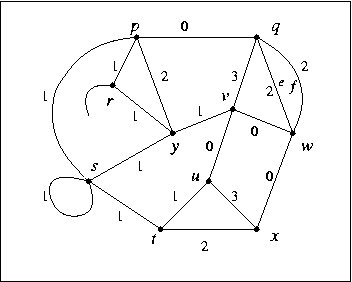Readings
Assignments
Week of
Problems
Basic Assignments
Week of
Hand-In Assignments
Written work: Your choices must be approved in advance by me. (This is to make sure they aren't too easy or too hard.)
Extra Problems
Extra problems on duality: PostScript file.
Extra problems on projective geometry (Section 6.1). (The most important is the second one.) Extra problems on the Möbius function. Extra problems on hyperplane arrangements. Problems on gain and biased graphs.
The point of this problem is that it tells you a simple way to know which point sets in an abstract projective geometry are flats.
* means an advanced problem.
Here is a PostScript version of the figure that prints nicely. 
Gain Graph GG1.
The gain group is Z4 . The gains on the diagram should be read in alphabetical order (from the "lower" to the "higher" letter). The funny-looking symbol that resembles "L" is 1.
A matroid M is a minor-minimal nonbias matroid (or a forbidden minor for bias matroids) if M is not the bias matroid of any biased graph, but every proper minor of M is the bias matroid of some biased graph.
A matroid M is a a forbidden minor for lift matroids of biased graphs if M is not the lift matroid of any biased graph, but every proper minor of M is the lift matroid of some biased graph.
These problems refer to the following list of biased graphs:
To the main course page.